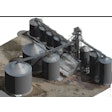
The Russian invasion of Ukraine over the last two weeks (at the time of this writing), has been heart wrenching, unsettling and scary to watch unfold.
Although I never experienced the Cold War fears and school bomb shelter drills of previous generations, it still feels like we’re in a time warp. I never imagined I’d live to see a Russian missile strike and seizure of Europe’s largest nuclear energy plant.
Ukraine and Russia’s war has implications for everyone in the world, especially regarding food and commodity prices. As two of the biggest players in grain trading, Ukraine and Russia combined account for more than a quarter of the world’s wheat trade and up to 20% of corn.
News of the war sent the wheat markets skyrocketing over supply and export fears. On March 4, the May Chicago wheat futures contract closed 41% higher than the previous week at $12.09, a record-breaking weekly gain.
After Ukraine’s Black Sea ports closed the U.S. filled some export sales that were expected to originate from there, but meeting the world’s future demand looks bleak, as tens of millions of grain acres in Russia and Ukraine remain compromised.
Economists and European ag groups called for opening protected acreage and fallow land to plant as many crops as possible and buffer the war’s impact on food prices, which had already hit a record high before Russia invaded Ukraine.
Scott Irwin, Laurence J. Norton Chair of Agricultural Marketing at the University of Illinois, said on Twitter, “There are up to 22 million acres of land available in the U.S. that was at one point cropped. ... My simple proposal is to let every CRP acre be eligible for cropping for 2022 and only 2022. No interruption of payments or contracts. Just change the rules on an emergency basis so it can be cropped if a farmer wants to risk it this year.”
Analysts have noted the ripple effect with nations battling to secure fertilizer shipments for planting season. While it’s impossible to say how long or brief this war will last, its disruption to global agriculture and supply chains will be felt for months to come.











